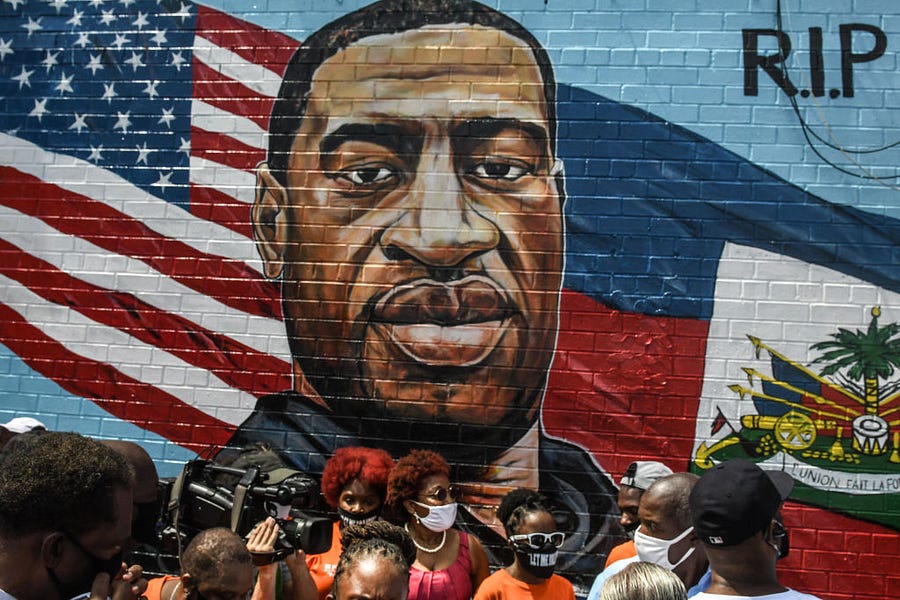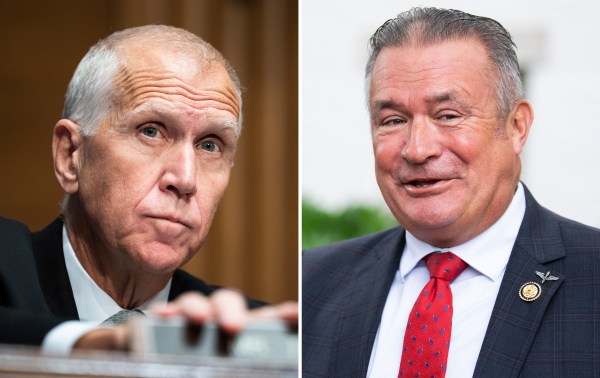Before I get to today’s main event (discussing newly released body camera footage of George Floyd’s death) we need to start with something else—masks. Yes, masks. The absolute dumbest culture war in America just flared again, and so I suppose at long last it’s time for a brief legal explainer on mask mandates.
Joe Biden delivered remarks yesterday in support of a nationwide mask mandate. He said, “Every single American should be wearing a mask when they’re outside for the next three months at a minimum. Every governor should mandate mandatory mask wearing.” Biden said that such a mandate could save up to 40,000 lives. Biden also said that this mandate was “not about your rights; it’s about your responsibilities.”
Trump attorney and senior legal adviser to his campaign, Jenna Ellis, responded immediately via Twitter:
Could a Biden administration implement a national mask mandate? Is there a protected liberty interest against wearing a mask? Let’s break this down.
First, it is highly doubtful that President Biden has the power to directly and immediately implement a universal, national masking requirement. The federal government simply lacks that degree of generalized police power, even during a pandemic. He can still likely get where he wants, however, but his administration would have to be mildly legally creative.
Biden can obviously require masks at federal installations and on property under federal control. The federal government may also use its regulatory rulemaking authority under the Occupational Safety and Health Act of 1970 to mandate masking at places of employment covered by the statute. In fact, given the widespread federal regulatory authority over even private workplaces, it’s likely that a comprehensive masking effort could draw on a wide variety of authorities to cover a substantial segment of the American workforce.
But to achieve a nationwide mandate, Biden would likely have to use the power of the purse. He could attempt to tie the receipt of substantial federal aid to the states on governors issuing statewide mask mandates. Many states are on the verge of a serious fiscal crisis, and tying a mask mandate to a federal bailout (with the justification that the mandate will ease the fiscal crisis by hastening recovery from the pandemic) would likely result in either a universal or near-universal mask requirement. Which governors would refuse federal financial assistance over masks?
And that brings us to the second question. If governors do what Biden wants and mandate masks, could citizens sue and overturn the ban? Almost certainly not. States already have broad authority to enact public health regulations. As the Supreme Court observed all the way back in 1824, states have the power to enact “quarantine laws” and “health laws of every description.”
Of course health laws don’t automatically trump constitutionally protected rights (though, as we’ve seen, in emergency circumstances, even fundamental, enumerated rights like free exercise of religion are subject to profound limits), but I’ve yet to read a convincing argument that wearing a mask infringes on a person’s First Amendment freedoms, or any other freedom protected by the Constitution.
Instead, the better analogy is that masking regulates our breath in much the same way we now regulate second-hand smoke. Bans on indoor smoking are ubiquitous in the United States, and they’ve been extensively litigated on both state and federal constitutional grounds. In pandemic conditions, my breath is far more potentially dangerous than smoke from my cigar or cigarette.
(In fact, if you click on the link in the state case, it will take you to a Kentucky Supreme Court case upholding the city of Lexington’s indoor smoking ban. I was co-counsel for the city, defending its ban.)
Beyond indoor smoking bans, bans on public indecency also show the scope of state control over clothing. If one argues that baring one’s face is an expressive act, then so is baring one’s body, yet challenges to prohibitions on public nudity consistently fail.
What’s the bottom line? Not to get crass, but if the state chooses to mandate masks, I have no more right to drop my mask in Target than I do to drop my pants.
A word about the new George Floyd body cam footage.
Last week the Daily Mail released a segment of relevant body cam footage from the arrest and killing of George Floyd. You can watch the segment here, but if you followed the case closely, nothing about it was surprising. You knew that he was obviously intoxicated and resisted arrest. You also knew that he told officers that he couldn’t breathe even before he was put on the ground. None of this was a mystery.
These facts were even in the criminal complaint against Derek Chauvin filed and released to the public on June 3:

Apparently, however, some folks were not aware of these facts and believed that the Daily Mail showed them something new, exploding the “narrative” of George Floyd’s death. Here was Jason Whitlock:
The behavior of the police officers seems appropriate and restrained given Floyd’s level of resistance and bizarre conduct. The footage reasonably explains how and why Floyd wound up on the ground with multiple officers restraining him.
The video does not justify officer Derek Chauvin kneeling on Floyd’s neck for nearly nine minutes. But it does offer context why Chauvin would be reluctant to believe Floyd’s “I can’t breathe” cries. Nearly every word out of Floyd’s mouth was a desperate lie.
Here are the takeaways from the footage:
-
Floyd’s behavior escalated a routine arrest into a possible abuse of force.
-
The George Floyd case is not a race crime. No rational person can watch that footage and conclude the police were motivated by Floyd’s black race.
-
It’s going to be virtually impossible to convict former officers Thomas Lane, J. Alexander Kueng and Tou Thao of any crime.
-
It will be equally difficult to convict Chauvin of murder.
Rod Dreher quoted Whitlock and added this:
When these police officers go free—as they will deserve to, based on what is seen on these cameras—riots are going to sweep the nation. As Whitlock says, sports stars, the media, and many others have promulgated a sacred narrative in which Floyd was the innocent victim of racist police officers. It is not true. I think a decent case could be made that Derek Chauvin used excessive force, even though the neck restraint was legal under Minneapolis police guidelines. But murder? Not remotely. You’re not going to get a conviction for that.
George Floyd is dead today almost entirely because of George Floyd. Watch that bodycam video above (it ends just as he is on the ground with Chauvin’s knee in his neck), and tell me how there is any other reasonable conclusion? All he had to do was obey the police, who gave him chance after chance after chance. They did not come down on him hard, with the neck restraint, because he was black. They came down on him because he hysterically resisted arrest, for at least eight minutes.
The media’s narrative is false. All the George Floyd riots, all the George Floyd protests, have been based on a lie. That lie, though, has become so fundamental to the left’s narrative that disbelieving it will be impossible for countless people.
(Rod later amended his post to say “Floyd is dead because Derek Chauvin knelt on his neck for eight minutes. That is a fact. Chauvin should have been charged with something—abuse of force?—but I don’t see how it constitutes murder.”)
I didn’t weigh in immediately, for two reasons. First, I was a little puzzled by the reaction. The only new thing I learned from the footage was that Floyd at one point requested to be put on the ground.
Second, I wanted to see more footage to get the entire context. It’s perilous to opine definitively about “new footage” when you know more footage is out there. Well, more footage has been released. Much more footage. You can see two of the officers’ full body cam footage at this Washington Post link, and I believe those complete videos will make it easier, not harder to obtain a conviction in the case.
Yes, the footage shows Floyd resisting, but—and this is crucial—it never shows him being a threat to the safety and well-being of the officers. Floyd is a problem for them, but he is not a threat to them.
Why is that relevant? Because it renders the officers actions utterly mystifying when it is obvious that Floyd is in immense physical distress. Whitlock emphasizes that Floyd’s previous claims he couldn’t breathe gave the officers reason to disbelieve Floyd when he also said he couldn’t breathe when he was on the ground.
Fair enough. But what about when they checked his pulse (because onlookers were begging officers to help Floyd), couldn’t find it, and yet kept kneeling on his prone body for “at least another two minutes”? Chauvin removed his knee only when the ambulance arrived, and chest compressions didn’t begin until Floyd was in the ambulance.
None of this means that a conviction is certain. Indeed, at The Dispatch we’ve run three excellent pieces by Minnesota law professor Ted Sampsell-Jones highlighting the possible challenges in the state prosecution of each of the officers. A principle challenge rests on proving causation:
Chauvin may contest that he caused Floyd’s death. At first blush, in light of the video, that may seem absurd. It looks obvious that Chauvin asphyxiated Floyd by kneeling on his neck. But the preliminary medical examination released on Friday was a bombshell. It found no physical evidence supporting asphyxia. The report suggests that Floyd’s death was “likely” caused by some combination of underlying heart issues, possible intoxicants, and police restraint. Floyd’s family countered by releasing a competing autopsy result on Monday. It concluded Floyd did indeed die of asphyxia.
Shortly thereafter on Monday evening, the medical examiner issued a more complete autopsy report. It classified the death as a homicide, and listed the cause of death as cardiopulmonary arrest with law enforcement restraint as a contributing cause. But it also noted that Floyd had underlying heart conditions—and that he was intoxicated on fentanyl at the time of death and had recently ingested methamphetamine. Both of those drugs can cause or contribute to acute cardiopulmonary events. The presence of multiple contributing causes muddies the waters.
As Sampsell-Jones notes, juries struggle to weigh the testimony of competing experts. Yet that’s exactly why perceptions of underlying fairness and justice can (but not always) have a substantial impact. And kneeling on a man with no measurable pulse makes absolutely no sense to any reasonable person.
No one disputes that police officers have difficult jobs. It is hard to safely arrest and pacify a grown, intoxicated man who doesn’t want to be put in the back of a squad car. No one should minimize that physical challenge, but as each minute ticked by with a knee on Floyd’s neck, the officers’ conduct became more mystifying and less justifiable.
One last thing …
I’ve said some tough things about police misconduct in this newsletter. It’s time to honor some real courage. This is body camera footage of a cop rescuing a man in a wheelchair stuck on the tracks with a train on the way. It’s incredible:







Please note that we at The Dispatch hold ourselves, our work, and our commenters to a higher standard than other places on the internet. We welcome comments that foster genuine debate or discussion—including comments critical of us or our work—but responses that include ad hominem attacks on fellow Dispatch members or are intended to stoke fear and anger may be moderated.
With your membership, you only have the ability to comment on The Morning Dispatch articles. Consider upgrading to join the conversation everywhere.